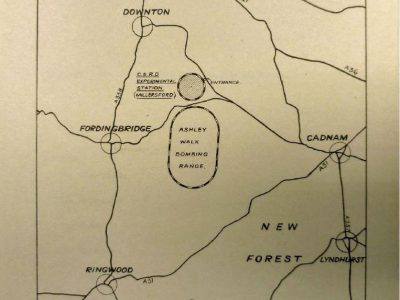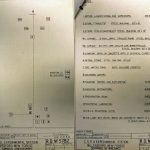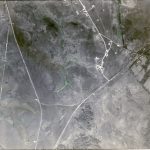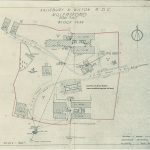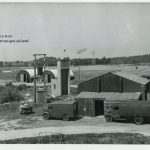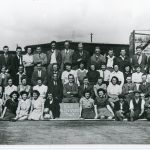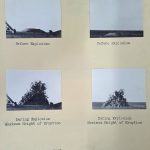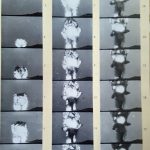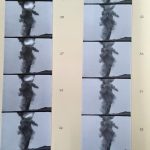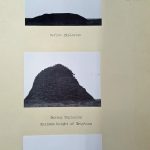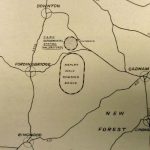Armaments Research Department – Millersford Overview
If you were to enjoy a walk from Turf Hill Carpark towards Turf Hill Enclosure and then on to Millersford you might notice several earth mounds that look remarkably like Bronze Age Barrows. However these mounds are the survivals of more recent human activity. If you had been doing the same walk from 1941 onwards you might have either been a signatory of the Official Secrets Act or about to get into trouble as a trespasser or even worse potentially about to lose some limbs. As this was the location of a WWII experimental site concerned with the testing of static explosives.
The experimental range here was not associated with the Ashley Walk Bombing Range across the road, but did move into the area because of the bombing range and to make use of some of the logistics and amenities put in place for it.
In January 1941 the Research Department Woolwich, Directorate of Explosives Research and Physics Branch relocated from Shoebury Ness on Essex coast due to invasion concern. The new range was nominally responsibility of Ministry of Supply, but was known as the Armaments Research Department.
An archive document made known to us by Peter Kirk dating to July 1940 deals with the site setup and requirements (some of which are included as images above)
1940 Description and Location
This area is intended for the static detonation trials of high explosive bombs with provision of necessary workshop and laboratory facilities to enable the measurements of fragmentation distribution penetration and velocity together with the measurements of blast velocity and pressure to be made. When necessary, photographic records by means of ultra-rapid cinematography can be obtained.
High chain link fence boundaries were erected to enclose a roughly circular area 1,000 yards in diameter with a point of entrance situated near the road from Cadnam to Downton. Two lookout points were also built with clear views of the range.
A number of administration buildings such as offices and stores were located were the current car park is and you can see some of the building platforms nearby (Specifically buildings number 4 & 5 on the 1948 Block Plan above). These were detailed in a 1940 drawing R.D.5782 and can be seen in some of the photos that we obtained with the oral histories.
The 1940 document provides us with a suggested site plan and building list, which can be handily compared to 1946 Aerial Images of the site, 2011 Lidar surveys and a map of the site layout produced by Anthony Passmore in his 1993 book: New Forest Explosives: Account of the Schultze Gunpowder Company Eyeworth and the Armaments Research Department Millersford. All of which show the original proposals didn’t differ too much from what actually came into existence on the site.
The heart of the range had a radius of 250 yards and was surrounded by seven laboratories protected by blast banks of earth. These included the Control Centre from which bombs detonated, two used for velocity and fragmentation experiments (An additional one was added after 1941), 2 for pressure readings, 1 for use as an electronic workshop for construction of high gain amplifiers. The closest laboratory to the blast area was only 100 yards from firing point and contained the Vinten high speed cine camera for filming the explosions.
Staffing
The 1940 document sets out the following staff demands for the site:
Scientific
- Scientist in charge of S.S.O.
- 4 E.O
- 2 E.A
- 2 Laboratory Assistants
Subordinates
- 1 Carpenter
- 1 Fitter
- 1 Lorry Driver for 3 ton lorry
- 4 Skilled labourers
- 1 Clerk
Some senior staff and twenty technical staff came as part of the relocation in 1941, but the rest of the staff were recruited locally (as you will see from some of the oral histories below). The numbers given above are a lot less than the staffing numbers the range ended up requiring as seen from a 1945 group photo we have from one of the staff members based at the range: Group Photo with names – SAE Millersford – 1945
Testing and Activities at the Range
The range originally tested 1,000lb bombs, but due to the impact on local property and the expenses of compensation as a result the range focused on 500lbs bombs.
Research in the National Archives has identified various reports (DSIR27/21) of some of the tests undertaken at Millersford including testing of explosions and shrapnel on items like air warden helmets, reinforced concrete slabs, ‘Clark Crete’ safety lights and other materials. One test undertaken at two sites was ‘Methods of limiting the actions of unexploded bombs’ full scale experiments were undertaken in clay soils at Stewartby in clay soils and at Ashley in sand soils using 250lb A.S. and 250kg. bombs buried in 10ft. and 12ft. 6in. deep respectively. The cover consisted of either loose sand or sandbags, and three methods of loading were compared:
- hand shovelling with a portable belt conveyor
- piling sandbags with a belt conveyor, and
- stacking sandbags by hand
The following measurements and observations were made:
- A profile of the ground configuration and sand covering before and after the explosion
- The maximum horizontal earth movement at various distances near the bomb, observed by means on inertia-type displacement meters
- The permanent horizontal and vertical earth movement at various distances near the bomb, as revealed by pegs in the earth
- High speed cine photography of the explosion. Speed of film varied from 64 to about 150 frames per second in different experiments
- The time required to erect the sand coverings
Some images from the tests can be found in photos above and you can read a copy of the report here
You can find more memories of Millersford Experimental Work By following these links to the Oral Histories and Personal Memories
Group Photo with names – SAE Millersford – 1945
Vera Storr – Memories of a secret Blast Tester at Millersford Range
Betty McCarthy – Memories of assistant photographer at Millersford Range
Barbara Smith – Memories of the secret work at Millersford Range
John Robinson – Blast Pressure Group. Armaments Research Test Range – Millersford Range
Roy Pilgrim – Superintendent, the Lancaster Crash and an unrecognised hero?


